 y.layout.AbstractLayoutStage
y.layout.AbstractLayoutStage
 y.layout.partial.PartialLayouter
y.layout.partial.PartialLayouter
|
Search this API | ||||||||
| PREV CLASS NEXT CLASS | FRAMES NO FRAMES | ||||||||
| SUMMARY: NESTED | FIELD | CONSTR | METHOD | DETAIL: FIELD | CONSTR | METHOD | ||||||||
java.lang.Objecty.layout.AbstractLayoutStage
y.layout.partial.PartialLayouter
public class PartialLayouter
This class represents a partial layout algorithm which changes the coordinates for a given set of graph elements (called partial elements) only. The location and size of the remaining elements (called fixed elements) is not allowed to be changed.
This partial layout algorithm offers a kind of generic partial layout support for other existing layout algorithms.
Hence, its layout style heavily depends on the selected
core layout algorithm as well as the specified
edge router or edge routing strategy.
The partial layout is suitable for applications where users may incrementally add new elements to an existing drawing. The added elements should be arranged so that they fit best possible into the given diagram without making any changes to the already existing layout. Hence, the so-called mental map of the existing drawing is preserved.
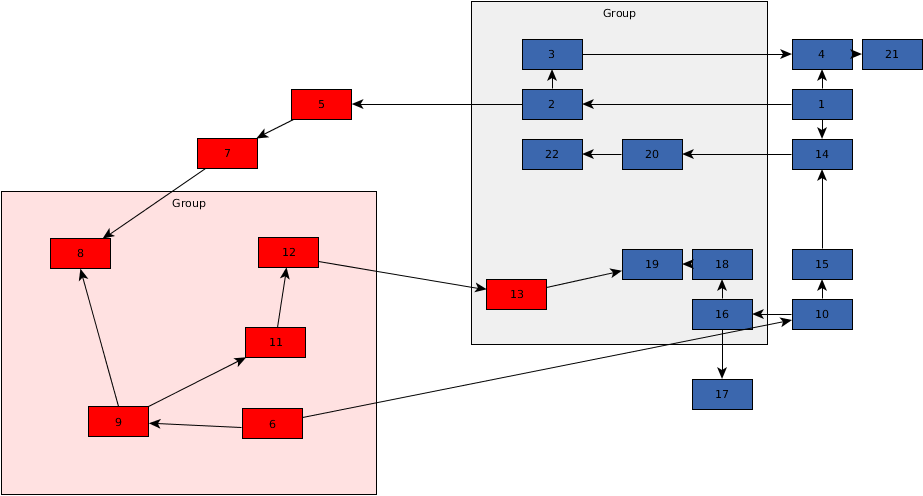
The input graph where marked nodes denote the partial elements that were incrementally added to the existing diagram.
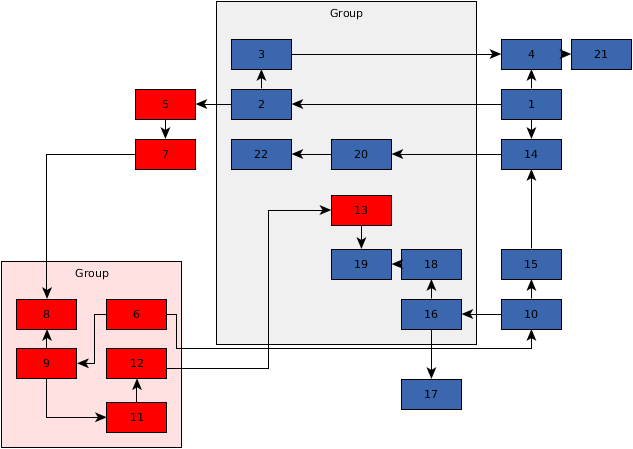
The result of a partial layout run with component assignment strategy set
to COMPONENT_ASSIGNMENT_STRATEGY_SINGLE and with node alignment enabled.
Similar to the layout style, the supported feature set mainly depends on the features supported by the specified
core layout algorithm as well as the specified
edge router or edge routing strategy.
The internal step that places the components
can handle group nodes and is able to consider minimum distance constraints.
Furthermore, the algorithm tries to place a subgraph component within the associated cell of the
PartitionGrid.
For this feature to work properly it is required that the values of the properties
ColumnDescriptor.getOriginalPosition(), RowDescriptor.getOriginalPosition()
ColumnDescriptor.getOriginalWidth() and RowDescriptor.getOriginalHeight()
are correctly specified.
Note that the algorithm does not guarantee that the calculated subgraph layout fits into the grid cell.
The layout algorithm tries to place the partial elements such that the resulting drawing (including the fixed elements) has a good quality with respect to common graph drawing aesthetics.
The layout algorithm handles each selected graph element as partial element. For this, it looks up the DataProvider
keys PARTIAL_NODES_DPKEY and PARTIAL_EDGES_DPKEY. Partial node elements can be
assigned to the so-called subgraph components. During the layout process each subgraph induced by the nodes of a
component is first laid out using the specified core layout algorithm. Then, the
different components are placed one-by-one onto the drawing area such that the number of overlaps among graph
elements is small. The user can specify different objectives for finding 'good' positions for subgraph components
(see setPositioningStrategy(byte)), e.g., SUBGRAPH_POSITIONING_STRATEGY_BARYCENTER specifies that the
component should be placed close to the barycenter of its graph neighbors and SUBGRAPH_POSITIONING_STRATEGY_FROM_SKETCH specifies that the component should be placed close to its original
position.
Method setComponentAssignmentStrategy(byte) allows to specify the strategy that assigns partial nodes to
subgraph components. Possible values are COMPONENT_ASSIGNMENT_STRATEGY_CLUSTERING,
COMPONENT_ASSIGNMENT_STRATEGY_CONNECTED, COMPONENT_ASSIGNMENT_STRATEGY_SINGLE and COMPONENT_ASSIGNMENT_STRATEGY_CUSTOMIZED. The last value allows to use a customized component assignment. Note that
nodes of a component cannot be assigned to different group nodes.
Furthermore, the user can specify the edge
routing strategy (see setEdgeRoutingStrategy(byte)) that is used for routing partial edges and edges
between different subgraph components (so-called inter-edges). Possible values are EDGE_ROUTING_STRATEGY_ORGANIC, EDGE_ROUTING_STRATEGY_ORTHOGONAL, EDGE_ROUTING_STRATEGY_STRAIGHTLINE, EDGE_ROUTING_STRATEGY_OCTILINEAR and
EDGE_ROUTING_STRATEGY_AUTOMATIC.
| Nested Class Summary | |
|---|---|
static class |
PartialLayouter.StraightLineEdgeRouter
Deprecated. Use class StraightLineEdgeRouter instead. |
| Field Summary | |
|---|---|
static java.lang.Object |
COMPONENT_ASSIGNMENT_DPKEY
A DataProvider key for defining custom subgraph components.
|
static byte |
COMPONENT_ASSIGNMENT_STRATEGY_CLUSTERING
A component assignment strategy where the subgraph components correspond to the clusters computed by a clustering algorithm based on edge betweenness centrality. |
static byte |
COMPONENT_ASSIGNMENT_STRATEGY_CONNECTED
A component assignment strategy where the subgraph components correspond to the connected components of the graph. |
static byte |
COMPONENT_ASSIGNMENT_STRATEGY_CUSTOMIZED
A component assignment strategy where the subgraph components are defined by the user. |
static byte |
COMPONENT_ASSIGNMENT_STRATEGY_SINGLE
A component assignment strategy that assigns each node to a separate subgraph component. |
static java.lang.Object |
DIRECTED_EDGES_DPKEY
A DataProvider key for specifying the edges that should be considered to be directed.
|
static byte |
EDGE_ROUTING_STRATEGY_AUTOMATIC
Automatically chooses a suitable routing strategy by analyzing the existing edge routes. |
static byte |
EDGE_ROUTING_STRATEGY_OCTILINEAR
A routing strategy that produces octilinear routes. |
static byte |
EDGE_ROUTING_STRATEGY_ORGANIC
A routing strategy that produces organic routes for partial edges and inter-edges. |
static byte |
EDGE_ROUTING_STRATEGY_ORTHOGONAL
A routing strategy that produces orthogonal routes. |
static byte |
EDGE_ROUTING_STRATEGY_STRAIGHTLINE
A routing strategy that produces straight-line routes. |
static byte |
ORIENTATION_AUTO_DETECTION
Layout orientation specifier where the orientation is automatically detected. |
static byte |
ORIENTATION_BOTTOM_TO_TOP
Layout orientation specifier which defines that the main layout orientation is from bottom to top. |
static byte |
ORIENTATION_LEFT_TO_RIGHT
Layout orientation specifier which defines that the main layout orientation is from left to right. |
static byte |
ORIENTATION_NONE
Layout orientation specifier where the layout orientation is completely ignored. |
static byte |
ORIENTATION_RIGHT_TO_LEFT
Layout orientation specifier which defines that the main layout orientation is from right to left. |
static byte |
ORIENTATION_TOP_TO_BOTTOM
Layout orientation specifier which defines that the main layout orientation is from top to bottom. |
static java.lang.Object |
PARTIAL_EDGES_DPKEY
A DataProvider key for marking partial edges.
|
static java.lang.Object |
PARTIAL_NODES_DPKEY
A DataProvider key for marking partial nodes.
|
static java.lang.String |
ROUTE_EDGE_DPKEY
A DataProvider key for obtaining the edges that should be routed by the edge router.
|
static byte |
SUBGRAPH_POSITIONING_STRATEGY_BARYCENTER
A positioning strategy which tries to place each subgraph component close to the barycenter of its graph neighbors. |
static byte |
SUBGRAPH_POSITIONING_STRATEGY_FROM_SKETCH
A positioning strategy which tries to place each subgraph component close to its original position. |
| Fields inherited from interface y.layout.Layouter |
|---|
EDGE_ID_DPKEY, NODE_ID_DPKEY, NODE_TYPE_DPKEY, SELECTED_EDGES, SELECTED_NODES |
| Constructor Summary | |
|---|---|
PartialLayouter()
Creates a new instance of PartialLayouter. |
|
PartialLayouter(Layouter subgraphLayouter)
Creates a new instance of PartialLayouter which uses the specified Layouter instance
as the core layout algorithm. |
|
| Method Summary | |
|---|---|
boolean |
canLayout(LayoutGraph graph)
Delegates the call to the specified core layout algorithm. |
protected void |
configureEdgeRouter(Layouter edgeRouter)
This method is called each time when edges are routed with an edge router. |
void |
doLayout(LayoutGraph graph)
This method calculates the partial layout. |
void |
doPartialLayout(LayoutGraph graph)
This method calculates the partial layout. |
byte |
getComponentAssignmentStrategy()
Returns the strategy that assigns partial nodes to subgraph components. |
Layouter |
getCoreLayouter()
Returns the Layouter instance that is applied to each subgraph component. |
Layouter |
getEdgeRouter()
Returns the custom edge router instance that is used for partial edges and edges between different subgraph components (so-called inter-edges). |
byte |
getEdgeRoutingStrategy()
Returns the routing strategy that is used for partial edges and inter-edges. |
byte |
getLayoutOrientation()
Returns the layout orientation that is considered during the placement of partial elements. |
long |
getMaximalDuration()
Returns the preferred time limit (in milliseconds) for the layout algorithm. |
int |
getMinimalNodeDistance()
Returns the minimum distance between two adjacent nodes. |
byte |
getPositioningStrategy()
Returns the objective used for finding 'good' positions for subgraph components. |
boolean |
isConsiderNodeAlignment()
Returns whether or not partial nodes should be aligned. |
boolean |
isFixedGroupResizingEnabled()
Returns whether or not fixed (non-partial) group nodes may be resized. |
boolean |
isMirroringAllowed()
Returns whether or not subgraph components are mirrored to improve the layout quality. |
boolean |
isMovingFixedElementsAllowed()
Returns whether or not the algorithm may move fixed elements. |
boolean |
isOrientationOptimizationEnabled()
Returns whether or not a postprocessing step should be applied to reduce the number of directed edges that do not comply with the specified layout orientation. |
boolean |
isPackComponentsEnabled()
Returns whether or not a subgraph component may be placed within another subgraph component. |
boolean |
isRouteInterEdgesImmediatelyEnabled()
Returns whether or not edges between different subgraph components should be routed immediately. |
protected void |
layoutSubgraph(LayoutGraph subGraph)
This method is called during the layout process
and calculates the layout for the given subgraph component using the specified
core layout algorithm. |
protected void |
placeSubgraphs(LayoutGraph graph,
NodeList[] subgraphComponents)
This method is called during the layout process
and places the subgraph components one-by-one onto the drawing area. |
protected void |
routeEdgesBetweenFixedElements(LayoutGraph graph,
EdgeList partialEdges)
This method is called during the layout process
and routes all partial edges that connect two fixed elements. |
protected void |
routeInterEdges(LayoutGraph graph,
EdgeList interEdges)
This method is called during the layout process
and routes all inter-edges. |
void |
setComponentAssignmentStrategy(byte strategy)
Specifies the strategy that assigns partial nodes to subgraph components. |
void |
setConsiderNodeAlignment(boolean considerNodeAlignment)
Specifies whether or not partial nodes should be aligned. |
void |
setCoreLayouter(Layouter layouter)
Specifies the Layouter instance that is applied to each subgraph component. |
void |
setEdgeRouter(Layouter edgeRouter)
Specifies the custom edge router instance that is used for partial edges and edges between different subgraph components (so-called inter-edges). |
void |
setEdgeRoutingStrategy(byte strategy)
Specifies the routing strategy that is used for partial edges and inter-edges. |
void |
setFixedGroupResizingEnabled(boolean fixedGroupResizingEnabled)
Specifies whether or not fixed (non-partial) group nodes may be resized. |
void |
setLayoutOrientation(byte layoutOrientation)
Specifies the layout orientation that is considered during the placement of partial elements. |
void |
setMaximalDuration(long maximalDuration)
Specifies the preferred time limit (in milliseconds) for the layout algorithm. |
void |
setMinimalNodeDistance(int minimalNodeDistance)
Specifies the minimum distance between two adjacent nodes. |
void |
setMirroringAllowed(boolean mirroringAllowed)
Specifies whether or not subgraph components are mirrored to improve the layout quality. |
void |
setMovingFixedElementsAllowed(boolean movingFixedElementsAllowed)
Specifies whether or not the algorithm may move fixed elements. |
void |
setOrientationOptimizationEnabled(boolean enabled)
Specifies whether or not a postprocessing step should be applied to reduce the number of directed edges that do not comply with the specified layout orientation. |
void |
setPackComponentsEnabled(boolean packComponentsEnabled)
Specifies whether or not a subgraph component may be placed within another subgraph component. |
void |
setPositioningStrategy(byte strategy)
Specifies the objective used for finding 'good' positions for subgraph components. |
void |
setRouteInterEdgesImmediatelyEnabled(boolean enabled)
Specifies whether or not edges between different subgraph components should be routed immediately. |
| Methods inherited from class y.layout.AbstractLayoutStage |
|---|
canLayoutCore, doLayoutCore |
| Methods inherited from class java.lang.Object |
|---|
clone, equals, finalize, getClass, hashCode, notify, notifyAll, toString, wait, wait, wait |
| Field Detail |
|---|
public static final java.lang.Object PARTIAL_NODES_DPKEY
DataProvider key for marking partial nodes.
PARTIAL_EDGES_DPKEYpublic static final java.lang.Object DIRECTED_EDGES_DPKEY
DataProvider key for specifying the edges that should be considered to be directed.
If a layout orientation is specified
(i.e., getLayoutOrientation() is not ORIENTATION_NONE),
the algorithm tries to route directed edges such that they adhere to that orientation.
DataProvider is not registered, all edges are considered to be directed.setLayoutOrientation(byte)public static final java.lang.Object PARTIAL_EDGES_DPKEY
DataProvider key for marking partial edges.
PARTIAL_NODES_DPKEYpublic static final java.lang.String ROUTE_EDGE_DPKEY
DataProvider key for obtaining the edges that should be routed by the edge router.
DataProvider must not be set by the user!
The key is used by this algorithm to temporarily add a DataProvider that marks edges that should be routed
by the specified edge router, see setEdgeRouter(y.layout.Layouter).setEdgeRouter(y.layout.Layouter),
Constant Field Valuespublic static final java.lang.Object COMPONENT_ASSIGNMENT_DPKEY
DataProvider key for defining custom subgraph components.
DataProvider is only considered if
setComponentAssignmentStrategy(byte) is set to COMPONENT_ASSIGNMENT_STRATEGY_CUSTOMIZED.COMPONENT_ASSIGNMENT_STRATEGY_CUSTOMIZED,
setComponentAssignmentStrategy(byte)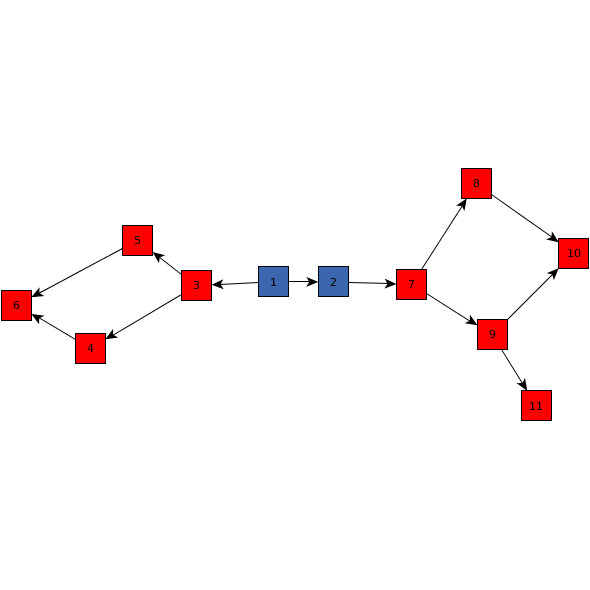 The input graph where nodes 1 and 2 are fixed while the remaining nodes are partial. | 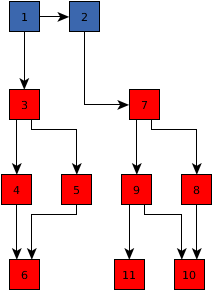 The result of a partial layout run with core layout algorithm set to
IncrementalHierarchicLayouter and
the component assignment strategy set to
COMPONENT_ASSIGNMENT_STRATEGY_CUSTOMIZED. Furthermore, in this example, the DataProvider associated
with this key returns the same object for all partial nodes and, thus, all nodes are assigned to the same component. |
public static final byte EDGE_ROUTING_STRATEGY_ORTHOGONAL
A route of an edge is called orthogonal if it only consists of vertical and horizontal segments.
setEdgeRoutingStrategy(byte),
ClearAreaLayouter.setEdgeRoutingStrategy(byte),
Constant Field Valuespublic static final byte EDGE_ROUTING_STRATEGY_STRAIGHTLINE
setEdgeRoutingStrategy(byte),
ClearAreaLayouter.setEdgeRoutingStrategy(byte),
Constant Field Valuespublic static final byte EDGE_ROUTING_STRATEGY_AUTOMATIC
If, for example, all edges have orthogonal edge routes, edges that are rerouted are routed orthogonally, too.
setEdgeRoutingStrategy(byte),
ClearAreaLayouter.setEdgeRoutingStrategy(byte),
Constant Field Valuespublic static final byte EDGE_ROUTING_STRATEGY_ORGANIC
setEdgeRoutingStrategy(byte),
ClearAreaLayouter.setEdgeRoutingStrategy(byte),
Constant Field Valuespublic static final byte EDGE_ROUTING_STRATEGY_OCTILINEAR
A route of an edge is called octilinear if the slope of each
segment is a multiple of 45 degrees.
setEdgeRoutingStrategy(byte),
ClearAreaLayouter.setEdgeRoutingStrategy(byte),
Constant Field Valuespublic static final byte COMPONENT_ASSIGNMENT_STRATEGY_SINGLE
setComponentAssignmentStrategy(byte),
ClearAreaLayouter.setComponentAssignmentStrategy(byte),
FillAreaLayouter.setComponentAssignmentStrategy(byte),
Constant Field Valuespublic static final byte COMPONENT_ASSIGNMENT_STRATEGY_CONNECTED
setComponentAssignmentStrategy(byte),
ClearAreaLayouter.setComponentAssignmentStrategy(byte),
FillAreaLayouter.setComponentAssignmentStrategy(byte),
Constant Field Valuespublic static final byte COMPONENT_ASSIGNMENT_STRATEGY_CLUSTERING
edge betweenness centrality.
setComponentAssignmentStrategy(byte),
ClearAreaLayouter.setComponentAssignmentStrategy(byte),
FillAreaLayouter.setComponentAssignmentStrategy(byte),
Constant Field Valuespublic static final byte COMPONENT_ASSIGNMENT_STRATEGY_CUSTOMIZED
setComponentAssignmentStrategy(byte),
ClearAreaLayouter.setComponentAssignmentStrategy(byte),
FillAreaLayouter.setComponentAssignmentStrategy(byte),
Constant Field Valuespublic static final byte SUBGRAPH_POSITIONING_STRATEGY_BARYCENTER
public static final byte SUBGRAPH_POSITIONING_STRATEGY_FROM_SKETCH
public static final byte ORIENTATION_TOP_TO_BOTTOM
setLayoutOrientation(byte),
ClearAreaLayouter.setLayoutOrientation(byte),
FillAreaLayouter.setLayoutOrientation(byte),
Constant Field Valuespublic static final byte ORIENTATION_BOTTOM_TO_TOP
setLayoutOrientation(byte),
ClearAreaLayouter.setLayoutOrientation(byte),
FillAreaLayouter.setLayoutOrientation(byte),
Constant Field Valuespublic static final byte ORIENTATION_LEFT_TO_RIGHT
setLayoutOrientation(byte),
ClearAreaLayouter.setLayoutOrientation(byte),
FillAreaLayouter.setLayoutOrientation(byte),
Constant Field Valuespublic static final byte ORIENTATION_RIGHT_TO_LEFT
setLayoutOrientation(byte),
ClearAreaLayouter.setLayoutOrientation(byte),
FillAreaLayouter.setLayoutOrientation(byte),
Constant Field Valuespublic static final byte ORIENTATION_AUTO_DETECTION
setLayoutOrientation(byte),
ClearAreaLayouter.setLayoutOrientation(byte),
FillAreaLayouter.setLayoutOrientation(byte),
Constant Field Valuespublic static final byte ORIENTATION_NONE
setLayoutOrientation(byte),
ClearAreaLayouter.setLayoutOrientation(byte),
FillAreaLayouter.setLayoutOrientation(byte),
Constant Field Values| Constructor Detail |
|---|
public PartialLayouter()
PartialLayouter.
public PartialLayouter(Layouter subgraphLayouter)
PartialLayouter which uses the specified Layouter instance
as the core layout algorithm. This instance is applied to each subgraph component,
see setComponentAssignmentStrategy(byte).
subgraphLayouter - the layout algorithm that is applied to the subgraph componentssetComponentAssignmentStrategy(byte)| Method Detail |
|---|
public boolean isMovingFixedElementsAllowed()
Even though the main objective of the partial layout is to keep non-partial elements fixed, it may sometimes be advantageous to allow to move them in order to obtain more suitable placements of the partial components. Especially if the partial components are quite large, it is very difficult to find a good place without moving fixed elements.
true if the algorithm may move fixed elements, false otherwise.setMovingFixedElementsAllowed(boolean)public void setMovingFixedElementsAllowed(boolean movingFixedElementsAllowed)
Even though the main objective of the partial layout is to keep non-partial elements fixed, it may sometimes be advantageous to allow to move them in order to obtain more suitable placements of the partial components. Especially if the partial components are quite large, it is very difficult to find a good place without moving fixed elements.
movingFixedElementsAllowed - true if the algorithm may move fixed elements, false otherwisepublic void setCoreLayouter(Layouter layouter)
Layouter instance that is applied to each subgraph component.
More precisely, during the layout process each subgraph induced by the (partial) nodes of a
component (see setComponentAssignmentStrategy(byte)) is first laid out using this instance.
setCoreLayouter in interface LayoutStagesetCoreLayouter in class AbstractLayoutStagelayouter - the Layouter instance that is applied to each subgraph component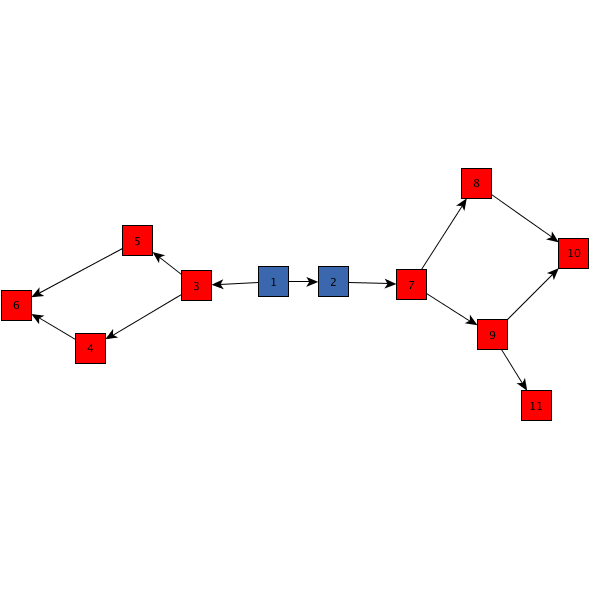 The input graph where nodes 1 and 2 are fixed while the remaining nodes are partial. | 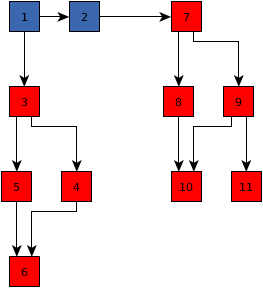 The result of a partial layout run with core layout algorithm set to
IncrementalHierarchicLayouter and
the component assignment strategy set to
COMPONENT_ASSIGNMENT_STRATEGY_CONNECTED. |
public Layouter getCoreLayouter()
Layouter instance that is applied to each subgraph component.
More precisely, during the layout process each subgraph induced by the (partial) nodes of a
component (see setComponentAssignmentStrategy(byte)) is first laid out using this instance.
getCoreLayouter in interface LayoutStagegetCoreLayouter in class AbstractLayoutStageLayouter instance that is applied to each subgraph componentsetCoreLayouter(Layouter)public long getMaximalDuration()
The specified value has to be greater than or equal to 0. If the value is
Integer.MAX_VALUE, the time is not limited.
setMaximalDuration(long)public void setMaximalDuration(long maximalDuration)
The specified value has to be greater than or equal to 0. If the value is
Integer.MAX_VALUE, the time is not limited.
Integer.MAX_VALUE. The time is not limited.maximalDuration - the preferred time limit
java.lang.IllegalArgumentException - if the maximum duration is negativepublic boolean isRouteInterEdgesImmediatelyEnabled()
true if edges between different subgraph components are routed immediately,
false otherwise.setRouteInterEdgesImmediatelyEnabled(boolean)public void setRouteInterEdgesImmediatelyEnabled(boolean enabled)
enabled - true if edges between different subgraph components should be routed immediately,
false otherwiserouteInterEdges(y.layout.LayoutGraph, y.base.EdgeList),
placeSubgraphs(y.layout.LayoutGraph, y.base.NodeList[])public boolean isPackComponentsEnabled()
true if a subgraph component may be placed within another subgraph
component, false otherwisesetPackComponentsEnabled(boolean)public void setPackComponentsEnabled(boolean packComponentsEnabled)
packComponentsEnabled - true if a subgraph component may be placed within another subgraph
component, false otherwisepublic boolean isFixedGroupResizingEnabled()
true if fixed group nodes may be resized, false otherwisesetFixedGroupResizingEnabled(boolean)public void setFixedGroupResizingEnabled(boolean fixedGroupResizingEnabled)
fixedGroupResizingEnabled - true if fixed group nodes may be resized,
false otherwisepublic byte getPositioningStrategy()
setPositioningStrategy(byte)public void setPositioningStrategy(byte strategy)
SUBGRAPH_POSITIONING_STRATEGY_BARYCENTER.
Each subgraph component is placed close to the barycenter of its graph neighbors.strategy - one of the predefined positioning strategies
java.lang.IllegalArgumentException - if the specified strategy does not match one of the predefined
positioning strategiespublic int getMinimalNodeDistance()
The specified value has to be non-negative.
setMinimalNodeDistance(int)public void setMinimalNodeDistance(int minimalNodeDistance)
The specified value has to be non-negative.
minimalNodeDistance - the non-negative minimum distance
java.lang.IllegalArgumentException - if the distance is negativepublic boolean isConsiderNodeAlignment()
core layout algorithm doesn't consider this option,
the alignment works best if the component assignment is set to
COMPONENT_ASSIGNMENT_STRATEGY_SINGLE.true if nodes are aligned, false otherwisesetConsiderNodeAlignment(boolean)public void setConsiderNodeAlignment(boolean considerNodeAlignment)
core layout algorithm doesn't consider this option,
the alignment works best if the component assignment is set to
COMPONENT_ASSIGNMENT_STRATEGY_SINGLE.considerNodeAlignment - true if nodes should be aligned, false otherwise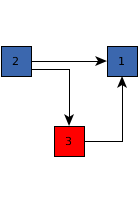 false - partial node 3 is not aligned with the other nodes. | 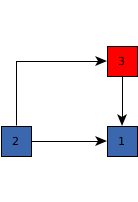 true - partial node 3 is horizontally aligned with node 1. |
public boolean canLayout(LayoutGraph graph)
core layout algorithm.
If no core layout algorithm is specified, this method always returns true.
graph - the input graph
true if the partial layout algorithm can be applied to the specified graph,
false otherwiseLayouter.doLayout(LayoutGraph)public byte getComponentAssignmentStrategy()
The specified core layout algorithm independently calculates the
layout for each subgraph component.
COMPONENT_ASSIGNMENT_STRATEGY_SINGLE: each partial node is a separate subgraph component.
The specified core layout doesn't have any effect because it is applied to each single node separately.
COMPONENT_ASSIGNMENT_STRATEGY_CONNECTED: components are defined by the connected components
of the graph induced by the partial elements.
COMPONENT_ASSIGNMENT_STRATEGY_CLUSTERING: components are defined by edge betweenness clustering.
COMPONENT_ASSIGNMENT_STRATEGY_CUSTOMIZED: components are user-defined.
Two partial nodes are considered to be in the same component if the DataProvider associated
with key COMPONENT_ASSIGNMENT_DPKEY returns the same object for both of them.
setComponentAssignmentStrategy(byte),
COMPONENT_ASSIGNMENT_DPKEY,
setCoreLayouter(Layouter)public void setComponentAssignmentStrategy(byte strategy)
The specified core layout algorithm independently calculates the
layout for each subgraph component.
COMPONENT_ASSIGNMENT_STRATEGY_SINGLE: each partial node is a separate subgraph component.
The specified core layout doesn't have any effect because it is applied to each single node separately.
COMPONENT_ASSIGNMENT_STRATEGY_CONNECTED: components are defined by the connected components
of the graph induced by the partial elements.
COMPONENT_ASSIGNMENT_STRATEGY_CLUSTERING: components are defined by edge betweenness clustering.
COMPONENT_ASSIGNMENT_STRATEGY_CUSTOMIZED: components are user-defined.
Two partial nodes are considered to be in the same component if the DataProvider associated
with key COMPONENT_ASSIGNMENT_DPKEY returns the same object for both of them.
COMPONENT_ASSIGNMENT_STRATEGY_SINGLE. Each partial node is assigned to a separate subgraph component.strategy - one of the predefined assignment strategies
java.lang.IllegalArgumentException - if the specified strategy does not match one of the predefined strategiesCOMPONENT_ASSIGNMENT_DPKEY,
setCoreLayouter(Layouter)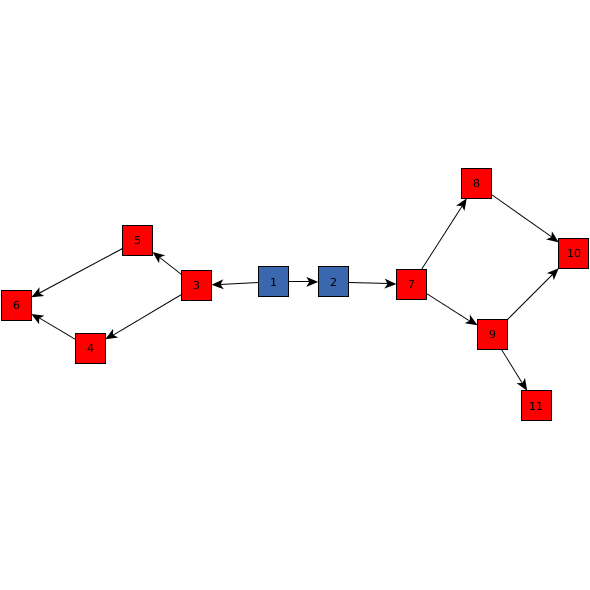 The input graph where nodes 1 and 2 are fixed while the remaining nodes are partial. | 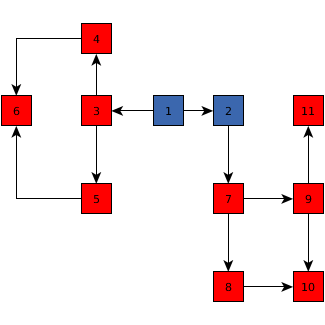 The result of a partial layout run with IncrementalHierarchicLayouter as core layout and
component assignment strategy COMPONENT_ASSIGNMENT_STRATEGY_SINGLE. | 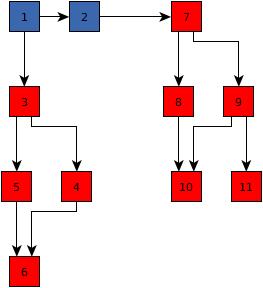 The result of a partial layout run with IncrementalHierarchicLayouter as core layout and
component assignment strategy COMPONENT_ASSIGNMENT_STRATEGY_CONNECTED. | 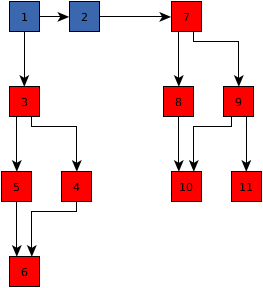 The result of a partial layout run with IncrementalHierarchicLayouter as core layout and
component assignment strategy COMPONENT_ASSIGNMENT_STRATEGY_CLUSTERING. | 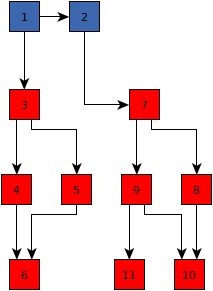 The result of a partial layout run with IncrementalHierarchicLayouter as core layout and
component assignment strategy COMPONENT_ASSIGNMENT_STRATEGY_CUSTOMIZED.
In this example, all nodes are manually assigned to the same component (i.e. the DataProvider associated
with key COMPONENT_ASSIGNMENT_DPKEY returns the same object for all partial nodes). |
public boolean isOrientationOptimizationEnabled()
true if this postprocessing step is applied, false otherwisesetOrientationOptimizationEnabled(boolean)public void setOrientationOptimizationEnabled(boolean enabled)
enabled - true if this postprocessing step should be applied, false otherwisesetLayoutOrientation(byte),
DIRECTED_EDGES_DPKEYpublic Layouter getEdgeRouter()
setEdgeRoutingStrategy(byte) automatically sets a new edge router instance
according to the specified routing strategy.DataProvider key ROUTE_EDGE_DPKEY. Hence, the specified router has to be configured such that it
observes this key and only routes marked edges!setEdgeRouter(y.layout.Layouter),
ROUTE_EDGE_DPKEY,
setEdgeRoutingStrategy(byte)public void setEdgeRouter(Layouter edgeRouter)
setEdgeRoutingStrategy(byte) automatically sets a new edge router instance
according to the specified routing strategy.DataProvider key ROUTE_EDGE_DPKEY. Hence, the specified router has to be configured such that it
observes this key and only routes marked edges!PartialLayouter.StraightLineEdgeRouteredgeRouter - the custom edge router instance that is used for partial edges and edges
between different subgraph componentsROUTE_EDGE_DPKEY,
setEdgeRoutingStrategy(byte)public byte getEdgeRoutingStrategy()
Inter-edges are edges between fixed and partial nodes as well as edges between different subgraph components. The available strategies are listed in the following.
EDGE_ROUTING_STRATEGY_STRAIGHTLINE produces straight-line edge routes.
EDGE_ROUTING_STRATEGY_ORTHOGONAL produces orthogonal edge routes.
EDGE_ROUTING_STRATEGY_OCTILINEAR produces octilinear edge routes.
EDGE_ROUTING_STRATEGY_ORGANIC produces organic edge routes.
EDGE_ROUTING_STRATEGY_AUTOMATIC automatically chooses a suitable strategy for the partial edges
inter-edges, based on the existing routes of the fixed edges.
setEdgeRouter(Layouter).setEdgeRoutingStrategy(byte),
setEdgeRouter(Layouter)public void setEdgeRoutingStrategy(byte strategy)
Inter-edges are edges between fixed and partial nodes as well as edges between different subgraph components. The available strategies are listed in the following.
EDGE_ROUTING_STRATEGY_STRAIGHTLINE produces straight-line edge routes.
EDGE_ROUTING_STRATEGY_ORTHOGONAL produces orthogonal edge routes.
EDGE_ROUTING_STRATEGY_OCTILINEAR produces octilinear edge routes.
EDGE_ROUTING_STRATEGY_ORGANIC produces organic edge routes.
EDGE_ROUTING_STRATEGY_AUTOMATIC automatically chooses a suitable strategy for the partial edges
inter-edges, based on the existing routes of the fixed edges.
setEdgeRouter(Layouter).EDGE_ROUTING_STRATEGY_STRAIGHTLINEstrategy - one of the predefined edge routing strategies
java.lang.IllegalArgumentException - if the specified strategy does not match one of the predefined routing strategiessetEdgeRouter(Layouter)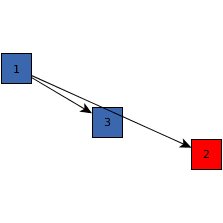 The input graph where node 2 is a partial node. | 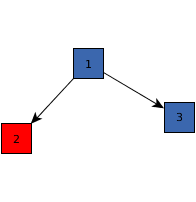 The result of a partial layout run with strategy EDGE_ROUTING_STRATEGY_STRAIGHTLINE. | 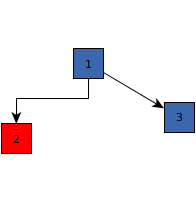 The result of a partial layout run with strategy EDGE_ROUTING_STRATEGY_ORTHOGONAL. | 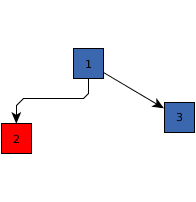 The result of a partial layout run with strategy EDGE_ROUTING_STRATEGY_OCTILINEAR. | 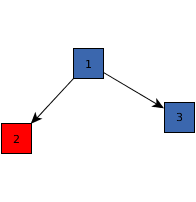 The result of a partial layout run with strategy EDGE_ROUTING_STRATEGY_ORGANIC. | 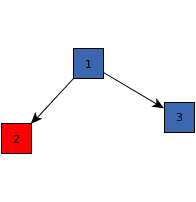 The result of a partial layout run with strategy EDGE_ROUTING_STRATEGY_AUTOMATIC. The algorithm
detects that the fixed edge between node 1 and 3 is routed straight-line and,
thus, routes the inter-edge straight-line, too. |
public byte getLayoutOrientation()
More precisely, the algorithm tries to place each subgraph component
such that each predecessor of a component's node v is placed
before v and each successor after v with respect to the layout orientation.
ORIENTATION_NONE: the layout orientation is completely ignored.
ORIENTATION_AUTO_DETECTION: the layout orientation is automatically detected.
The algorithm analyzes the flow direction of fixed edges in the current drawing.
If there is no common flow direction, the results are the same as for ORIENTATION_NONE.
Otherwise, the layout orientation is one of the four main orientation.
ORIENTATION_TOP_TO_BOTTOM: the algorithm tries to place partial nodes (subgraph components) such
that each predecessor of a node v is placed above v and each
successor below v.
ORIENTATION_BOTTOM_TO_TOP: the algorithm tries to place partial nodes (subgraph components) such
that each predecessor of a node v is placed below v and each
successor above v.
ORIENTATION_LEFT_TO_RIGHT: the algorithm tries to place partial nodes (subgraph components) such
that each predecessor of a node v is placed to the left of v and each
successor to the right of v.
ORIENTATION_RIGHT_TO_LEFT: the algorithm tries to place partial nodes (subgraph components) such
that each predecessor of a node v is placed to the right of v and each
successor to the left of v.
directed edges. For nodes of the same subgraph component the layout orientation
depends on the chosen core layout algorithm.setLayoutOrientation(byte),
DIRECTED_EDGES_DPKEYpublic void setLayoutOrientation(byte layoutOrientation)
More precisely, the algorithm tries to place each subgraph component
such that each predecessor of a component's node v is placed
before v and each successor after v with respect to the layout orientation.
ORIENTATION_NONE: the layout orientation is completely ignored.
ORIENTATION_AUTO_DETECTION: the layout orientation is automatically detected.
The algorithm analyzes the flow direction of fixed edges in the current drawing.
If there is no common flow direction, the results are the same as for ORIENTATION_NONE.
Otherwise, the layout orientation is one of the four main orientation.
ORIENTATION_TOP_TO_BOTTOM: the algorithm tries to place partial nodes (subgraph components) such
that each predecessor of a node v is placed above v and each
successor below v.
ORIENTATION_BOTTOM_TO_TOP: the algorithm tries to place partial nodes (subgraph components) such
that each predecessor of a node v is placed below v and each
successor above v.
ORIENTATION_LEFT_TO_RIGHT: the algorithm tries to place partial nodes (subgraph components) such
that each predecessor of a node v is placed to the left of v and each
successor to the right of v.
ORIENTATION_RIGHT_TO_LEFT: the algorithm tries to place partial nodes (subgraph components) such
that each predecessor of a node v is placed to the right of v and each
successor to the left of v.
directed edges. For nodes of the same subgraph component the layout orientation
depends on the chosen core layout algorithm.ORIENTATION_NONE. The layout orientation is completely ignored.layoutOrientation - one of the predefined layout orientations
java.lang.IllegalArgumentException - if the specified orientation does not match one of the predefined orientationsDIRECTED_EDGES_DPKEY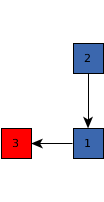 ORIENTATION_NONE: the partial node 3 is placed without considering the layout orientation. | ORIENTATION_AUTO_DETECTION: the layout algorithm detects that the placement of the fixed nodes
(node 1 and 2) corresponds to ORIENTATION_TOP_TO_BOTTOM placement and, thus,
uses this orientation during the placement of the partial node (node 3). | ORIENTATION_TOP_TO_BOTTOM: the fixed node 1 is a predecessor of the partial node
3 and, thus, according to the ORIENTATION_TOP_TO_BOTTOM placement rule, node 3
is placed below node 1. | 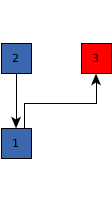 ORIENTATION_BOTTOM_TO_TOP: the fixed node 1 is a predecessor of the partial node
3 and, thus, according to the ORIENTATION_BOTTOM_TO_TOP placement rule,
node 3 is placed above node 1. Note that the location of the fixed nodes
(node 1 and 2) is not changed. | 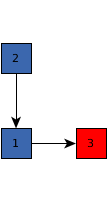 ORIENTATION_LEFT_TO_RIGHT: the fixed node 1 is a predecessor of the partial node
3 and, thus, according to the ORIENTATION_LEFT_TO_RIGHT placement rule, node 3
is placed to the right of node 1. Note that the location of the fixed nodes
(node 1 and 2) is not changed. | 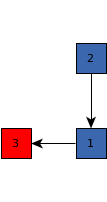 ORIENTATION_RIGHT_TO_LEFT: the fixed node 1 is a predecessor of the partial node
3 and, thus, according to the ORIENTATION_RIGHT_TO_LEFT placement rule, node 3
is placed to the left of node 1. Note that the location of the fixed nodes
(node 1 and 2) is not changed. |
public boolean isMirroringAllowed()
true if subgraph components are mirrored, false otherwisesetMirroringAllowed(boolean)public void setMirroringAllowed(boolean mirroringAllowed)
mirroringAllowed - true if subgraph components should be mirrored, false otherwise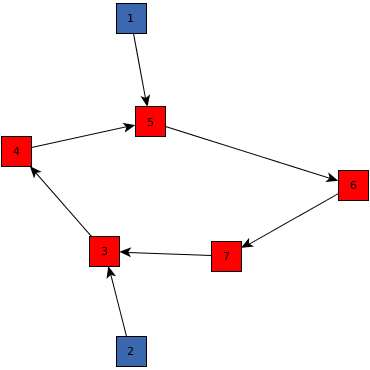 The input graph where node 1 and 2 are fixed while the remaining nodes are partial.
The partial layout is applied to this graph with core layout algorithm set to
SingleCycleLayouter and
the component assignment strategy set to
COMPONENT_ASSIGNMENT_STRATEGY_CONNECTED. | 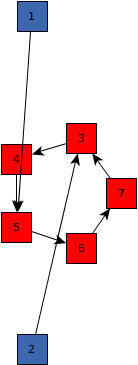 false | 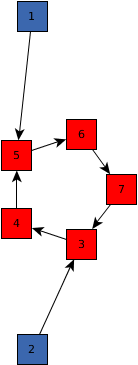 true |
public void doLayout(LayoutGraph graph)
routeEdgesBetweenFixedElements(y.layout.LayoutGraph, y.base.EdgeList)layoutSubgraph(y.layout.LayoutGraph) for each subgraph componentplaceSubgraphs(y.layout.LayoutGraph, y.base.NodeList[])routeInterEdges(y.layout.LayoutGraph, y.base.EdgeList)
OrientationLayouter. Hence, they
always assume that the graph is drawn from top to bottom.graph - the input graphLayouter.canLayout(LayoutGraph)public void doPartialLayout(LayoutGraph graph)
doLayout(LayoutGraph).graph - the input graphprotected void layoutSubgraph(LayoutGraph subGraph)
layout process
and calculates the layout for the given subgraph component using the specified
core layout algorithm.
It is called once for each subgraph component.
Subclasses may implement a custom layout strategy or add some additional data.
subGraph - the subgraph component
protected void placeSubgraphs(LayoutGraph graph,
NodeList[] subgraphComponents)
layout process
and places the subgraph components one-by-one onto the drawing area.
Therefore, it considers the specified
objective for finding a suitable position.
Subclasses may implement a custom placement strategy or add some additional data. However, they must not modify the given subgraph component lists.
graph - the input graphsubgraphComponents - each entry contains a NodeList that induces a subgraph component
protected void routeInterEdges(LayoutGraph graph,
EdgeList interEdges)
layout process
and routes all inter-edges.
Inter-edges are edges between different
subgraph components including edges between fixed and partial elements.
For the routing, this method uses the edge router instance set with method
setEdgeRouter(y.layout.Layouter). If no edge router was specified
by the user, it uses an internal edge router with routing strategy
getEdgeRoutingStrategy().
Subclasses may implement a custom routing strategy or add some additional data.
graph - the relevant subgraphinterEdges - the list of inter-edges to be routed
protected void routeEdgesBetweenFixedElements(LayoutGraph graph,
EdgeList partialEdges)
layout process
and routes all partial edges that connect two fixed elements. It either uses a
custom edge router or
an internal edge router that produces routes according to the specified
routing strategy.
Subclasses may implement a custom routing strategy or add some additional data.
graph - the subgraph of the input graph induced by the fixed nodespartialEdges - the list of partial edges to be routedprotected void configureEdgeRouter(Layouter edgeRouter)
Subclasses may modify the configuration of the given edge router instance.
The type of the given instance depends on the edge routing strategy, i.e.,
if the routing strategy is set to EDGE_ROUTING_STRATEGY_OCTILINEAR or
EDGE_ROUTING_STRATEGY_ORTHOGONAL it's an instance of EdgeRouter,
if the routing strategy is set
to EDGE_ROUTING_STRATEGY_ORGANIC it's an instance of OrganicEdgeRouter,
and, if the routing
strategy is set to EDGE_ROUTING_STRATEGY_STRAIGHTLINE it's an instance of
PartialLayouter.StraightLineEdgeRouter.
If the edge routing strategy is set to EDGE_ROUTING_STRATEGY_AUTOMATIC,
the layout algorithm chooses one of the above strategies
that best fits the routing style of the fixed edges.
setEdgeRouter(y.layout.Layouter)),
its instance corresponds to that of the parameter.edgeRouter - the instance used for routing the edgessetEdgeRouter(y.layout.Layouter),
setEdgeRoutingStrategy(byte)
|
© Copyright 2000-2025, yWorks GmbH. All rights reserved. |
||||||||
| PREV CLASS NEXT CLASS | FRAMES NO FRAMES | ||||||||
| SUMMARY: NESTED | FIELD | CONSTR | METHOD | DETAIL: FIELD | CONSTR | METHOD | ||||||||